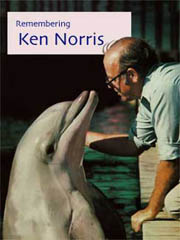
January 24, 2000
Beloved naturalist and visionary honored with book publication and library exhibit
By Barbara McKenna
The remarkable legacy of the man behind such visionary programs as UC's Natural Reserve
System and the federal Marine Mammal Protection Act is being celebrated through a
special exhibition at the University of California, Santa Cruz, currently taking
place in the campus's Science and McHenry Libraries.
 |
A reception will take place on Friday, January 28, from 4 to 6 p.m. in the McHenry Library foyer. A special event is also planned in conjunction with the exhibition on Sunday, February 20, from 2 to 4 p.m. at the Santa Cruz Public Library when the library's "Science Matters" program will feature a panel discussion on a new oral-history biography of Norris.
The biography is titled Kenneth S. Norris: Naturalist, Cetologist & Conservationist, 1924-1998 and was released in 1999 by UCSC's Regional History Project.
Norris (1924-1998), was an avid naturalist known for his passion for his work and for teaching. A professor of natural history at UCSC for 18 years, Norris retired in 1990. His extensive legacy includes the founding of UCSC's Long Marine Laboratory and the campus's Institute of Marine Sciences. For many years he also conducted the celebrated "Natural History Field Quarter" class, in which students traveled together across California with Norris and studied the state's diverse natural habitats. Norris also conducted extensive research for and helped author the federal Marine Mammal Protection Act of 1972.
Norris is also known as the scientist who verified the use of echolocation (or sonar) used by some marine mammals for navigation. William McFarland, professor emeritus of zoology at Cornell University and a longtime colleague, describes Norris's discovery of echolocation in the oral history.
"What Ken discovered from watching and doing experiments with the porpoises in the tanks was that they scanned, and as they approached an object, the scanning would become more rapid. He thought that what they were doing was listening with each side to the echoes and sort of nulling it out, so to speak, to hone in on it at the end. The frequency went up as they got closer to an object. . . . So he built all of that. That was, to me, brilliant. . . . and it turned out to be just so controversial that people wouldn't believe him until Ted Bullock showed that that was indeed what was happening."
Norris's discovery process combined patient observation, great intelligence, and keen intuition. In the same oral history, Norris explains to editor Randall Jarrell, "I have managed to get the reputation as somebody who sees things that other people don't see, but they don't know why. So, they all say, 'Well, let Norris play. He's usually right.' That been a true thing throughout . . . especially in the latter part of my career when some of the fetters come off your mind and you say, 'Oh damn it, I'm going to say this. I know it's right so I'm going to say it.' That's where my reputation as a scientist has come from. I have been right about a lot of things that people have been surprised at often, I think."
It was also Norris who was behind the establishment of the Natural Reserve System--33 sites across the state administered by the University of California. According to Roger Samuelsen, former director of the Natural Reserve System (NRS) and senior associate to the chancellor at UC Merced, it was Norris who put together the blueprint for the whole program. Norris convinced the UC Regents to consider the idea of protecting natural areas for the purpose of preservation and field study, and, says Samuelsen, "he literally took an entire semester in the spring of 1966 and toured the state. . . . I've read how he borrowed a jeep and a dictating machine and was off and running." Norris visited nearly 100 sites and proposed an acquisition plan that ultimately led to the establishment of the NRS.
The current exhibit features photographs, illustrations, books, field journal entries, and memorabilia. At McHenry Library, two upright cases are devoted to the "Natural History Field Quarter" class; other cases highlight Norris's teaching career, a collection of "Kenisms," his research in desert ecology and herpetology, and publications from the Environmental Field Studies Program. The exhibit at the Science Library highlights Norris's pioneering research on dolphins and whales, his confirmation of dolphin echolocation, and his role in the crafting of the Marine Mammal Protection Act.
For more information, contact Irene Reti at (831) 459-2847 or ihreti@cats.ucsc.edu.